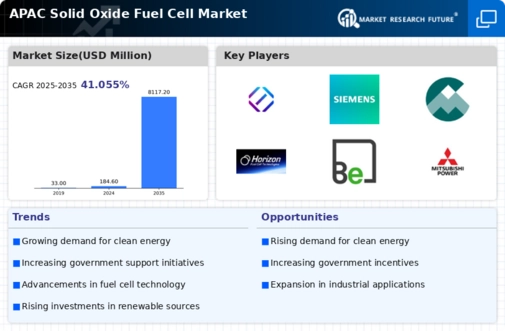The APAC Solid Oxide Fuel Cell Market is steadily evolving, characterized by a competitive landscape that reflects both the innovation and demand for cleaner energy sources. With increasing concerns over environmental sustainability and a shift towards renewable energy, solid oxide fuel cells (SOFCs) have gained prominence due to their high efficiency and low emissions. Various players are vying for a significant share of the market, employing different strategies that include technological advancements, partnerships, and investments in research and development.
The growing number of applications for SOFCs, from stationary power generation to backup systems, underscores the market's potential for expansion while companies navigate challenges such as production costs and regulatory frameworks across the diverse regions of Asia-Pacific.
In the context of the APAC Solid Oxide Fuel Cell Market, Blast Auxiliary is recognized for its robust market presence and commitment to innovation. The company harnesses cutting-edge technology to develop efficient fuel cell systems that cater to a wide range of applications. One of Blast Auxiliary's key advantages is its focus on enhancing fuel cell performance, ensuring reliability and longevity in varying operational conditions. This commitment to quality and performance provides the company with a competitive edge, allowing it to effectively meet the specific needs of customers in the APAC region.
With strong manufacturing capabilities, Blast Auxiliary is well-positioned to take advantage of growing demand, especially as industries focus on reducing their carbon footprints and seeking alternative energy solutions.
FuelCell Energy is another key player in the APAC Solid Oxide Fuel Cell Market, known for its comprehensive portfolio of clean energy solutions. The company specializes in providing high-efficiency fuel cell systems designed for stationary power generation, making significant contributions to reducing greenhouse gas emissions across various sectors. Its product offerings include state-of-the-art fuel cell power plants that leverage advanced technology to maximize energy output. FuelCell Energy has been actively involved in strategic partnerships and collaborations within the APAC region, enabling it to increase its market share.
Additionally, the company has taken steps toward expanding its operational footprint through mergers and acquisitions, enhancing its capabilities and market influence. This strategic approach, combined with a strong commitment to research and development, solidifies FuelCell Energy's position as a formidable contender in meeting the unique energy demands of the APAC market while advancing the adoption of solid oxide fuel cell technology.



















Leave a Comment